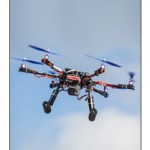 Coming soon to the sky near you may be a modern-day honeybee, aka an unmanned aerial vehicle (UAV), the official name of a “drone.” UAVs have made an important appearance at each of these recent events:
Coming soon to the sky near you may be a modern-day honeybee, aka an unmanned aerial vehicle (UAV), the official name of a “drone.” UAVs have made an important appearance at each of these recent events:
- The great Boston blizzard of 2015
- A fire at a peanut factory in Georgia
- Journalism classes at the University of Missouri
And now the law is evolving to catch up to technology, which introduces a nest of important issues concerning privacy, security and commercial freedoms. That contrasts with the simple origins of a drone, the male honeybee who, unlike worker bees, needs not worry about gathering nectar or pollen. By the 16th century, “drone” referred to lazy individuals, too.
But in 2015, a drone is no longer a slacker. The city of Boston used UAVs over roofs of city buildings to assess snow accumulation and determine the best method of removal. Firefighters in Georgia utilized a drone to provide aerial footage so they could survey the magnitude and location of the peanut factory fire. And in Columbia, Missouri, a j-school professor is teaching his students to operate drones for video, photography and investigative reporting, as part of a new journalism toolbox.
The Federal Aviation Administration (FAA) has recently proposed regulations as drones proliferate over the horizon. The FAA’s draft rules would make it relatively simple for real estate agents, aerial photographers, police departments, farmers and anyone else to fly small drones for work purposes. Operators would need to pass a written proficiency test, register the drone and pay about $200 in fees — but would not have to obtain a regular pilot’s license or demonstrate their flying skills.
The proposed regulations carry some significant limitations. Businesses would be allowed to fly drones only during daylight hours. And drones would have to remain within eyesight of the operator or observers posted on the ground. The drones could fly no more than 100 mph and would have to stay below an altitude of 500 feet to avoid the risk of colliding with other aircraft.
But what about privacy? Can we ensure that drone operators would “bee” careful not to invade personal rights? The FAA’s only mention of this issue is that drones would be prohibited from flying over bystanders not directly involved in their operation.
Missouri law recognizes a claim for invasion of privacy based on “intrusion upon seclusion.” It requires proof (1) of private and secret subject matter, (2) that at all times there was a right to keep that subject matter private and secret from third parties, and (3) that another person gained access to the private and secret subject matter through unreasonable means.
Would a drone flight constitute such an intrusion? In a recent case in Missouri federal court, a former employee claimed that GPS installed on his company van violated his privacy rights under this tort. Ultimately, the court disagreed, holding that the highly public information as to the van’s location was not a private matter. And, because the van was the property of the defendant, the use of the tracking device on its own vehicle did not rise to the level of being highly offensive to a reasonable person.
Federal agencies that operate drones must notify the public about where they plan to operate the drones in the national airspace, inform the public about any changes that might affect privacy and civil liberties, and provide the public with an annual summary of the agency’s drone operations during the previous year.
In the future, courts will have to address emerging issues about whether the flight of the drones will “sting” already established legal parameters. For its part, the FAA has established a 60-day window for comments from the public as to the drone rules. Further refinement is expected in the near future.
